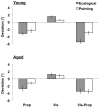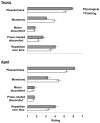Exploring the effects of ecological activities during exposure to optical prisms in healthy individuals
- PMID: 23408549
- PMCID: PMC3569946
- DOI: 10.3389/fnhum.2013.00029
Exploring the effects of ecological activities during exposure to optical prisms in healthy individuals
Abstract
Prism adaptation improves a wide range of manifestations of left spatial neglect in right-brain-damaged patients. The typical paradigm consists in repeated pointing movements to visual targets, while patients wear prism goggles that displace the visual scene rightwards. Recently, we demonstrated the efficacy of a novel adaptation procedure, involving a variety of every-day visuo-motor activities. This "ecological" procedure proved to be as effective as the repetitive pointing adaptation task in ameliorating symptoms of spatial neglect, and was better tolerated by patients. However, the absence of adaptation and aftereffects measures for the ecological treatment did not allow for a full comparison of the two procedures. This is important in the light of recent findings showing that the magnitude of prism-induced aftereffects may predict recovery from spatial neglect. Here, we investigated prism-induced adaptation and aftereffects after ecological and pointing adaptation procedures. Forty-eight neurologically healthy participants (young and aged groups) were exposed to rightward shifting prisms while they performed the ecological or the pointing procedures, in separate days. Before and after prism exposure, participants performed proprioceptive, visual, and visual-proprioceptive tasks to assess prism-induced aftereffects. Participants adapted to the prisms during both procedures. Importantly, the ecological procedure induced greater aftereffects in the proprioceptive task (for both the young and the aged groups) and in the visual-proprioceptive task (young group). A similar trend was found for the visual task in both groups. Finally, participants rated the ecological procedure as more pleasant, less monotonous, and more sustainable than the pointing procedure. These results qualify ecological visuo-motor activities as an effective prism-adaptation procedure, suitable for the rehabilitation of spatial neglect.
Keywords: aftereffects; ecological; pointing; prism adaptation; rehabilitation; right brain damage; spatial neglect.
Figures


References
-
- Arene N. U., Hillis A. E. (2007). Rehabilitation of unilateral spatial neglect and neuroimaging. Eura. Medicophys. 43, 255–269 - PubMed
LinkOut - more resources
Full Text Sources
Other Literature Sources

